How to make training more engaging: 8 essential tips
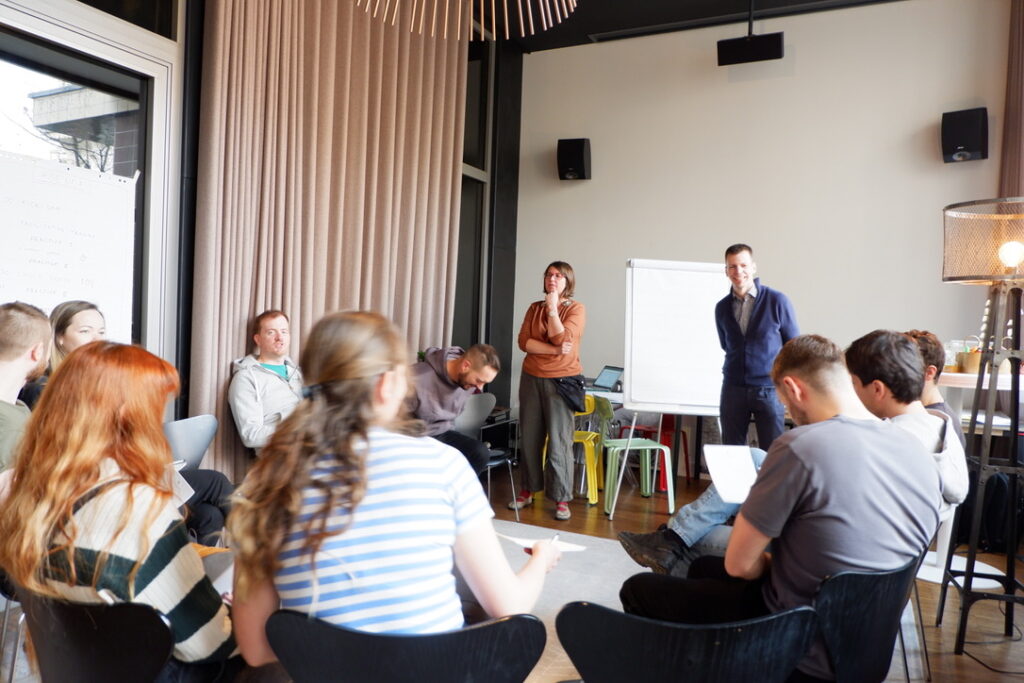
You can have the best content in the world, the most updated statistics and information, but when it comes to training, great training content is just not enough.
We’ve all sat through sessions that feel like (and in fact, are) a slow march through a PowerPoint deck. The information might be useful, but it is not memorable. In an era of distractions and short attention spans, what can help us design training that actually sticks?
In this article, we will look at 8 essential tips to make in-person or virtual training more engaging, with plenty of real-life stories and examples from my own experience training newbies in facilitation and group dynamics.
Think back at any training course you’ve taken part in that you’d say was a success, in whole or in part. What made it such? It may have been particularly relevant to your needs in life and work at the time. Perhaps you got a lot of energy from sharing with other participants. Real-life applications may have helped you get a feel of efficacy. And there was probably some fun involved, as well as moments of insight and reflection.
Let’s talk about that “fun” aspect for a moment. Yes, a good training is often fun, but this should not be limited to bells and whistles, or games and quizzes. Training engagement is not just about keeping people entertained. Especially when training professionals, effective employee training is about creating meaningful learning experiences: ones that lead to action, behavior change, and real-world application.
Here is what we will explore in this article:
Why engagement matters in training
When participants are actively engaged, the impact of training increases significantly. I’ve recently run a quick pre-training survey with a cohort of 30 professionals working for a development agency; one of the questions I asked was about previous training experiences they’d had. Which were good, and effective, in their view? What made the bad ones bad?
Their answers are probably unsurprising, yet always worth repeating. Content overload, and hour-long PowerPoint presentations, make for terrible learning experiences. The subject matter is soon forgotten, and all that’s remembered is the headache. Engaging with other participants, a balanced mix of content and practice, and practical applications were the top answers as to what makes a training good.
Here are three key benefits of truly engaging training:
- Better knowledge retention and memory. When adult learners are involved in the learning process, they’re far more likely to remember and apply what they’ve learned.
- Higher likelihood of application. The more people connect with and engage in the training, the more they’ll take away lessons that translate into action.
- Increased motivation. Engagement fuels curiosity, connection, and enthusiasm: making learning an active rather than passive experience.

So how do we go beyond surface-level engagement and create training sessions that truly connect with learners?
Interaction vs. engagement: what’s the difference?
It’s easy to assume that more interaction = more engagement. But that’s not always true. Online training expert and author of The Quest newsletter Gwyn Wansbrough recently illuminated the difference.
The problem is that interactive tools alone aren’t enough.
⚡️Interaction invites participation
Think of interaction as the way participants interface with your session. Polls, chats, and word clouds make it easier for people to contribute ideas and experiences. And that gives you and your group valuable “raw material” to work with.
💡 Engagement makes it meaningful
Engagement is about the depth and quality of the experience. How your participants connect with you, the content, and each other. It’s what transforms that raw material into lasting insights.
Interaction can be thought of as the way participants interface with your session. Engagement is about depth. It’s what transforms interaction into lasting insights.
- It’s about the social interaction: how participants connect with the content, with each other, and with you as the trainer.
- It’s what makes learning feel personal, relevant, and applicable.
How do we turn interaction into engagement?
Let’s take a classic example. At the start of a workshop, a trainer might ask participants a simple question, such as “In one word, what do you expect from this training?”. This is a fairly standard way to ask people to check in and start interacting. It’s easy to set up (I usually use Mentimeter) and responses are quick to collect.
One click later, you are displaying a wordcloud of responses on a shared (online) or projected (IRL, that is, in real life) screen. This is a good example of interaction. How can we turn it into engagement?
It just takes one extra step, a step steeped in meaning. Instead of simply collecting word cloud responses, take a moment to narrate what you see, draw connections between ideas, and invite a few people to elaborate and contribute. That small shift turns a basic interaction into a deeper engagement moment.
While planning your training, consider the importance of engagement throughout. How can you turn each moment of interaction into something deeper? Often it’s about asking a follow-up question, or inviting a few voices to reflect out loud on what happened so far.
8 practical tips to make your training more engaging
There is no single formula for engagement, but there are strategies that consistently make learning more dynamic, memorable, and impactful.
In the next paragraphs we’ll go through 8 tips for deepening engagement in training experiences, whether you are running training courses online or in person, in a one-off workshop or a longer online learning course.
To each step, I’ve added examples and stories from recent trainings I’ve held to upskill students and professionals in facilitation skills. My hope is that these personal stories might help make these tips practical and bring them to life for you. If you want to read more about how I work with beginners to upskill them in facilitation, here is the full story!
1. Set (and communicate) clear learning objectives.
Start with the end in mind. What should participants be able to do, know, or explain by the end of the session? You probably have based your training design on some clear objectives, but now it’s a matter of framing and communicating them to participants. What are some effective ways of doing this?
Every year, I train a new group of international students in facilitation and group dynamics. A challenge I face at the onset is that they find this mysterious topic, facilitation, in their syllabus, but in most cases they have never heard of it before. While some may have work experience, most are in the middle of their undergraduate degrees. Although I am confident they will need collaboration and facilitation skills in their future jobs, they do not know that yet. How can I frame the training program in such a way as to make the learning objectives clear for them?
Personally, I often begin with an active listening activity. I pair students up and ask them to take turns completing open sentences such as:
- When I have worked on projects together with other people I’ve enjoyed it because…
- When I have worked on projects together with other people it’s been very hard because…
- I think working with other people is…
Discussing learning objectives in this way shifts training from being something that is delivered to something that invites active exploration. Adult learners need clear objectives that can connect the activities at hand with their overall professional development. Other engaging ways of sharing learning objectives include:
- Writing them up in a poster and opening a discussion: what do these learning objectives mean to you?
- Asking participants to journal, or draw, their intentions for the session;
- Collecting sticky notes that answer the question “how do you think you might apply learnings on this session’s topic to your daily work?”
Even in virtual training or self-paced online learning, this step can be vital in ensuring participants truly enrol in their own learning journey. I usually ask participants to reflect on their personal goals before diving into any online courses in full.

2. Start with a check-in
At the beginning of a training session, I used to jump straight into the agenda. After all, time is limited, and there’s always a lot to cover. But over the years, I’ve realized that taking even a few minutes for a check-in makes a huge difference in how engaged people are throughout the session.
These days, I keep it simple: I ask participants to share how they’re doing. Not a clever icebreaker, not a carefully crafted question: just a straightforward invitation to say a few words about their current state.
While this might seem like a small thing, it gives me valuable information. If someone says, “I’m exhausted; it’s been a long week,” or “I’m feeling a little lost on this topic,” that tells me how I might need to adjust my approach. If the energy in the room is low, I know I might need to incorporate more movement or discussion early on. If people come in feeling overwhelmed, I can acknowledge that and create space for focus rather than adding more cognitive overload.
Beyond giving me insight into the group, a check-in also serves another important function: it gets people speaking early. The earlier someone speaks in a session, the more likely they are to contribute again later. When people have the opportunity to express themselves in the first few minutes, it reduces the social barrier to speaking up again. I usually invite a round if the group is small, and use the chat function or a Mentimeter poll if we are working online or the group is too large for a full tour de table.
A check-in doesn’t have to take long, and it doesn’t have to be complicated. It’s simply an opportunity to meet learners where they are and invite them into the space as active participants. When working with the same group repeatedly, you’ll need a reservoir of different check-in questions. For some inspiration, here is a list of 221 to get inspired by!
3. Connect new knowledge to existing knowledge
People learn best when they relate new ideas to what they already know. Training that helps learners build bridges between past experiences and new concepts leads to deeper understanding.
One way to do this is to begin a topic by asking participants what they already know about it. This approach helps surface prior knowledge and makes learning feel more relevant and connected.
For example, when I introduce a session on facilitation or group dynamics, I often start by asking participants to describe their past experiences working in groups: what worked well, what was challenging, and what made those experiences either productive or frustrating. As they share, I take mental notes (or sometimes jot key words down on a poster), paying attention to the language and examples they use. If they talk about “group vibe” rather than “dynamics,” for example, I’ll try to reflect that back in my explanations instead of relying on my usual jargon and terminology.
4. Structure your session logically
Training should feel like a logical progression, not a collection of unrelated activities. A well-structured session guides learners through a sequence of ideas, ensuring that each part builds upon the last. When learning feels disjointed or rushed, engagement drops. On the other hand, a well-planned structure creates a flow, making it easier for participants to absorb and apply new knowledge.
One reliable approach is Kolb’s experiential learning cycle, a model that highlights how people learn best through a continuous process of experience, reflection, conceptualization, and active experimentation. According to Kolb:
- Start each module of your training with a concrete experience. This can be a game or activity, something tangible or relatable that connects them to the topic.
- Next, invite participants to engage in reflective observation, analyzing and making sense of that experience. “What did you notice? What happened? How did it feel? Why do you think things went as they did?”
- Next comes abstract conceptualization, where new ideas, frameworks, or theories are introduced. This is the part most closely associated with the idea of a “training”, where you as trainer will provide theories and mental models to make sense of the experience.
- Finally, learners move into active experimentation, applying what they’ve learned in a practical exercise. If there is not enough time for case studies or role play, asking people to make their own action plans and reflect on how they might apply learning in real life is a valid way to complete this step.
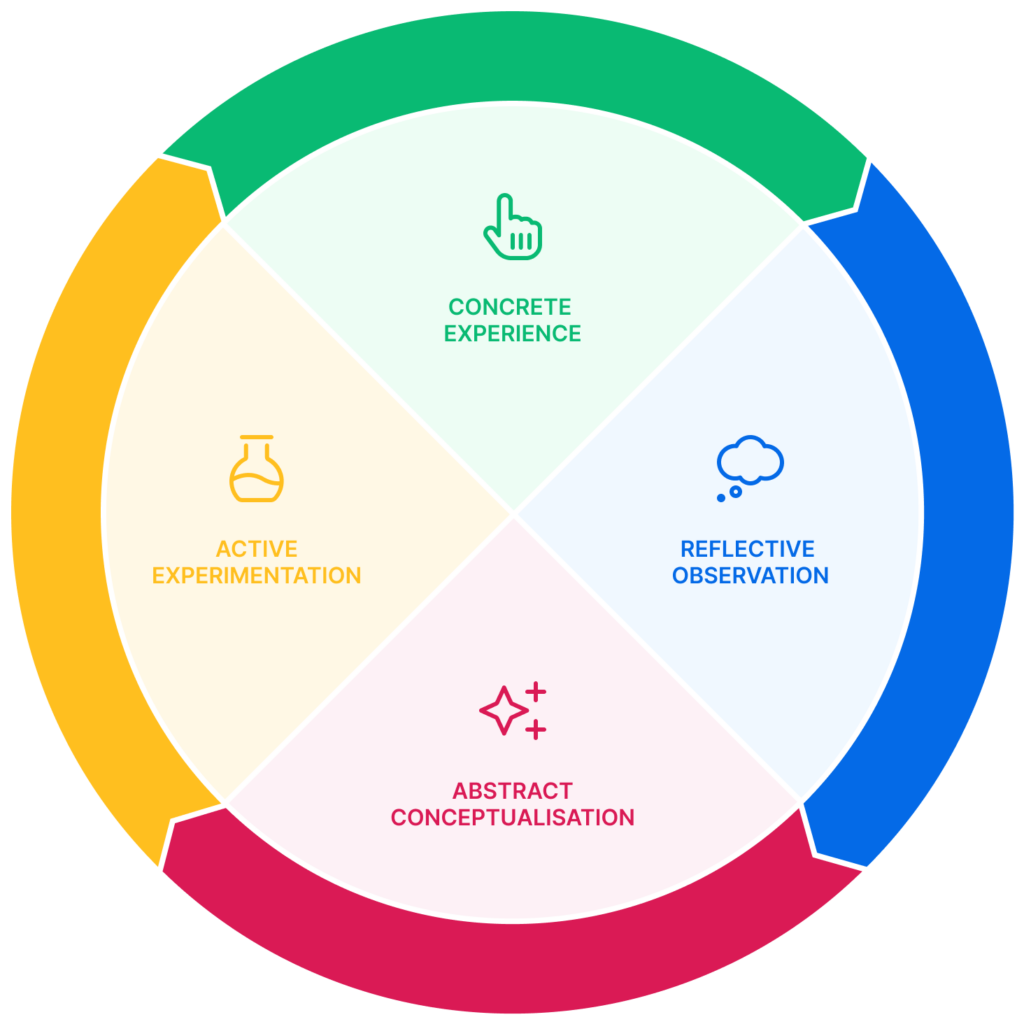
As facilitators or trainers with a slant towards facilitation, we might fall into the trap of leading a great activity without connecting it to the flow of the day or (cardinal sin!) without giving time for reflective observation, that is, a debrief.
I generally structure a lot of reflection time around each activity, both for the whole group and with journaling time for each participant to reflect individually on their learning.
To start designing a training session founded upon the structure of Kolb’s learning cycle, look no further than this training session template. In it you will find different sections for each part of the cycle, and you can easily duplicate it in SessionLab’s planner to customize it to your needs.

5. Keep it practical. Use real-world examples and case studies
Theory is important, but practical application is what makes learning stick. Providing concrete examples, case studies, and real-world scenarios helps participants see how they can apply what they’re learning in their own contexts. The more relevant and actionable the content, the better.
One way I ensure practicality in my sessions is by designing activities that serve a dual purpose: allowing participants to both practice facilitation tools and engage with real-world challenges at the same time. For example, I often include a World Café exercise where participants generate discussion topics based on real situations they have encountered in their work. The topics are not pre-selected: they emerge from the group’s experiences, making the conversation immediately relevant.
This approach achieves two things at once: first, it allows participants to practice the World Café method itself, experiencing what it’s like to facilitate and take part in the process. Second, it provides a structured way for them to discuss and problem-solve around real-life challenges. Rather than practicing facilitation with hypothetical examples, they apply it to topics that matter to them right now. This is a key strategy for making training more engaging.
6. Switch modes to keep energy high and cater to different learning styles
Avoiding long stretches of passive listening is essential for keeping participants engaged. By varying training methods you create opportunities for different kinds of learners to connect with the material. A good mix of listening, speaking, writing, and movement helps reinforce learning, prevent fatigue, and sustain energy throughout the session.
One way I remind myself to do this is by recognizing my own biases as a trainer. Left to my own devices, I tend to create training courses that are engaging for people who think like me. I learn best through dialogue and discussion, so I naturally design sessions filled with conversations and verbal exchanges.
But I know that if I don’t make a conscious effort, I risk leaving out those who process information differently, including those who need quiet reflection, movement, or visual expression to fully engage with the content. Thinking about those people who may need training materials on paper or in a visual style can help ensure no learner is left behind.

For that reason, I intentionally incorporate moments of silent journaling, energetic movement-based activities, and even drawing, which is far from my own comfort zone. And yet, these are often the moments that surprise and delight me the most.
Recently, in a facilitation training, I asked participants to draw their own metaphors for the role of a facilitator. One participant sketched a can of WD-40 lubricant, explaining that a facilitator helps things move smoothly, reduces friction, and gets teams unstuck. I could never have come up with such a metaphor myself, but it perfectly captured an essential aspect of facilitation.
If you are looking for a few ideas of activities and games you might want to include in your next training session to shift the energy or making your training fun, here is a collection of 24 of our favorite engaging training games.
7. Incorporate regular breaks
Giving participants time to pause and process information is one of the simplest and most effective ways to keep engagement high. Even a quick two-minute stretch, a short walk, or a moment of silence can reset focus and improve retention.
When I plan a training session, one of the first things I do in SessionLab’s planner is add a start time, an end time, and some bright-yellow blocks for structured breaks. If I don’t plan for them upfront, it’s too easy to push through and assume energy levels will hold. But they won’t: without breaks, even the most interactive session starts to feel exhausting.
A simple trick I’ve learned is to start with shorter breaks and make them longer as the day goes on. The first break might be just five minutes: a quick reset. By mid-afternoon, when energy naturally dips, a longer break helps keep engagement up rather than letting fatigue set in.
Research into participatory activities suggests that a 15-minute break every 90 minutes is ideal for maintaining focus and energy levels. This aligns with research on biological rhythms, particularly something called the ultradian rhythm, which describes the body’s natural cycles of activity and rest. After about 90 minutes of sustained effort, cognitive performance starts to decline, making structured breaks not just beneficial but biologically necessary.

Breaks also create space for informal discussion and reflection. Some of the best insights don’t happen during training activities, but over coffee, when participants have time to process what they’ve learned. I often notice that after a break, someone who had been quiet in the first half of a session will suddenly speak up with a new idea or connection they’ve made.
And a small but effective trick: take a group picture at the end of a break. It’s a lighthearted way to bring people back together, and it subtly signals that the session is resuming. When the group sees others gathering, they naturally follow suit, making transitions smoother.
8. The best trainers listen to the group and adapt
No matter how well you design a training session, real engagement happens when participants feel that the session is for them: that it reflects their needs, interests, and learning styles. And the only way to do that effectively? Ask, listen, and adapt.
I aim to collect feedback mid-session, not just at the end, usually right before lunch. I ask three simple questions:
- What’s going well that you’d like more of?
- What’s not working as well, and what could we adjust?
- Any other suggestions or ideas for me?
This quick check-in allows me to course-correct in real time. If participants are deeply engaged in discussions, I might create more space for reflection and dialogue. If they’re feeling restless, I might introduce a movement-based activity or switch things up with a game.
This flexibility is possible because I design training with clear learning objectives, but without rigid adherence to every planned activity. The goal is to ensure that learning happens in a way that resonates with the group, not to complete a “perfect” checklist of activities. Over the past few years, I’ve seen just how much variation there can be between groups, even when delivering the same core training:
- One group thrived on deep discussions and critical reflection.
- Another preferred gamified activities: the more interactive and playful, the better.
- A third, just this year, engaged most when given time for individual journaling and quiet processing.
There’s no way to predict these preferences in advance. As a trainer, you can come in with your best guesses, but ultimately, the group will tell you what works for them: if you ask.
And while adapting mid-session improves engagement in the moment, gathering feedback at the end of a session helps refine the training for next time. It’s where I collect ideas I might not have thought of, discover which methods landed best, and notice what could be streamlined or improved.
Pro tip: I keep some notes on what worked best and what I’d like to change in a note at the end of my session plan in SessionLab, so that next time I open it to copy and create a new session, my precious feedback is right there.
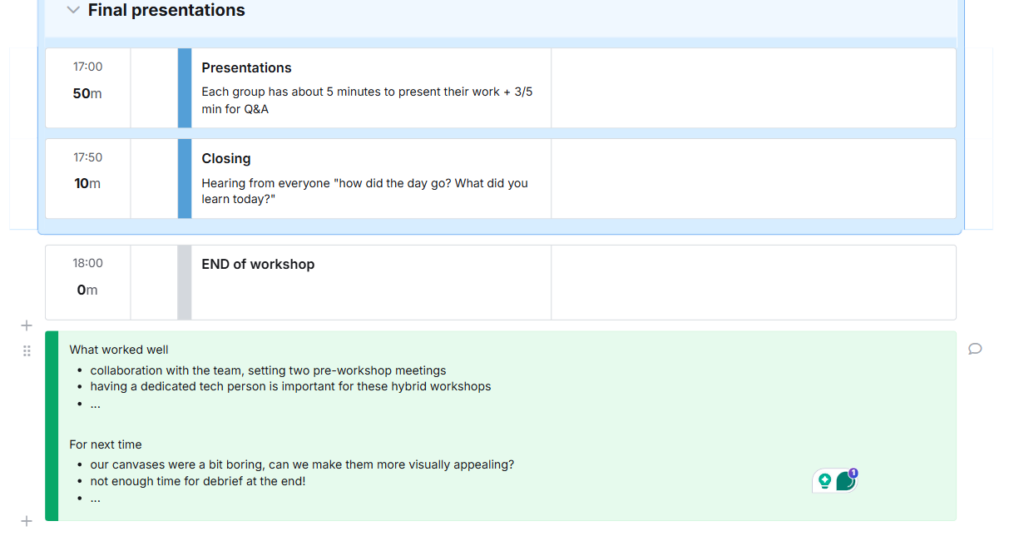
How to make online, self-paced training courses more engaging too!
While the eight tips previously discussed are tailored for live training environments, whether online or in-person, many can be adapted to improve self-paced courses as well. Online, self-paced courses and MOOCs (Massive Open Online Courses) have many benefits for learners: with no set dates or times, they are accessible to people from any timezone, and especially well-suited for those balancing family responsibilities or demanding work schedules. While there are natural limitations to the level of interactivity in a fully asynchronous format, that doesn’t mean course designers are out of options; it’s totally possible to be creative in this format as well.
Here are six practical ideas for making self-paced courses more engaging. Do you have more? Add them in the comments or join discussions in our friendly community.
- Invite participants to keep a learning journal. Self-reflection is a powerful part of the learning process. From the very beginning of the course, prompt participants with reflection questions and encourage them to keep a personal journal of their thoughts, reactions, and takeaways. Start by inviting learners to articulate why they joined the course and what they hope to gain. As the course progresses, use reflective prompts to deepen learning, reinforce key ideas, and help participants make personal connections to the material.
- Incorporate videos. Videos are a staple of online learning, because they work to bring learning to life. It’s important to keep them short, purposeful, and human. Rather than long, lecture-style recordings, consider using brief explainer videos, animated walkthroughs, or informal selfie-style clips from instructors. These can break up the reading load and help maintain a sense of personal connection in an otherwise solo learning journey.
- Pepper the course with quizzes (and make them fun!). Quizzes don’t have to feel like school tests. Use them as opportunities for learners to check their understanding and reinforce key concepts in a light, interactive way. Include playful elements like badges, instant feedback, or a “did you know?” fact alongside correct answers. This not only aids retention but also builds confidence and keeps energy levels up.
- Design exercises with real-world scenarios. Help learners bridge theory and practice by including activities based on real-life challenges they might face. Whether it’s a case study, a role-play prompt, or a problem-solving exercise, context-rich scenarios give learners a chance to apply knowledge meaningfully, making the course content feel more relevant and memorable.
- Provide opportunities for peer interaction, even asynchronously. Self-paced doesn’t have to mean isolated. Consider building in optional discussion forums, reflection boards, or shared project spaces where participants can exchange ideas, ask questions, or share insights. Even if learners aren’t online at the same time, knowing there’s a space to connect with others can increase motivation and create a more communal learning experience.
- Use progress tracking and gentle nudges. A visible sense of progress can be motivating in itself. Use progress bars, milestone markers, or completion checklists to help learners track how far they’ve come. Combine these with automated nudges—friendly reminders, encouragement messages, or timely prompts to resume the course. Aim to make participants supported without feeling pressured (remember the death of Duo?)
With thoughtful design choices, even asynchronous courses can become memorable, engaging learning experiences. The key is to think beyond content delivery and consider how you can support motivation, connection, and reflection throughout the learners’ journey.
How SessionLab can help make your training more engaging
As we’ve seen in these 8 tips, engaging training isn’t just about great facilitation in the moment: it also comes down to careful planning and clever structuring. That’s where SessionLab can help. Whether you’re designing a short workshop or a multi-day training, SessionLab provides the tools to make planning easier, more flexible, and—most importantly—more engaging for participants.
1. Structure your session with variety, at a glance
One of the keys to engagement is switching modes throughout a session to keep energy high and cater to different learning styles. SessionLab’s color-coded blocks make it easy to visualize the flow of activities, ensuring that you’re not relying too heavily on one type of learning method. You can quickly see if you have too much presentation time, too few interactive elements, or if reflective exercises are missing, and adjust accordingly.
And of course, SessionLab helps keep track of timing and breaks. With an intuitive planner that adjusts in real-time, you can make sure that breaks are well-placed and that activities don’t run over, helping maintain the right balance of focus and rest.
2. Enrich your session with a library of activities
Even the best training plans need a fresh spark of inspiration from time to time. With SessionLab’s facilitation library of over 1400 methods, you can always find an energizer, a game, or an interactive activity to enhance your session. To start exploring, check out this collection of active learning activities and strategies.
3. Start with a high-quality training agenda
Rather than building from scratch, why not start with a proven training agenda? SessionLab offers a range of training templates, including this Essential Training Session Plan, a structured yet flexible starting point for designing a high-impact session based on Kolb’s learning cycle.
4. Learn and connect with a community of trainers
Trainers, facilitators, and educators also need a space to learn, experiment, and grow. On the SessionLab blog, you’ll find a wealth of articles on facilitation, training, and learning design, offering both practical strategies and deeper insights into how to make training more engaging.
And if you’re looking for new ideas or want to share your experiences, join our community of trainers and facilitators! Learning from others is one of the best ways to keep improving your own sessions.
And if you’ve applied any of the tips from this article to make your training sessions more engaging, I’d love to hear from you: drop a note in the comments!

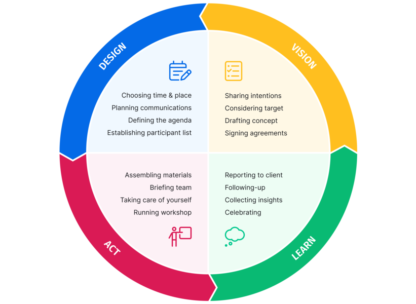

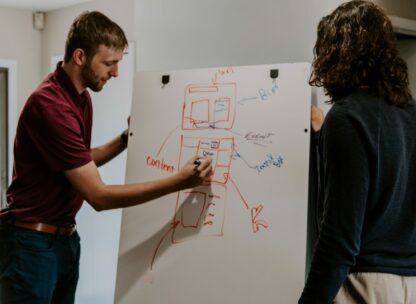
Leave a Comment